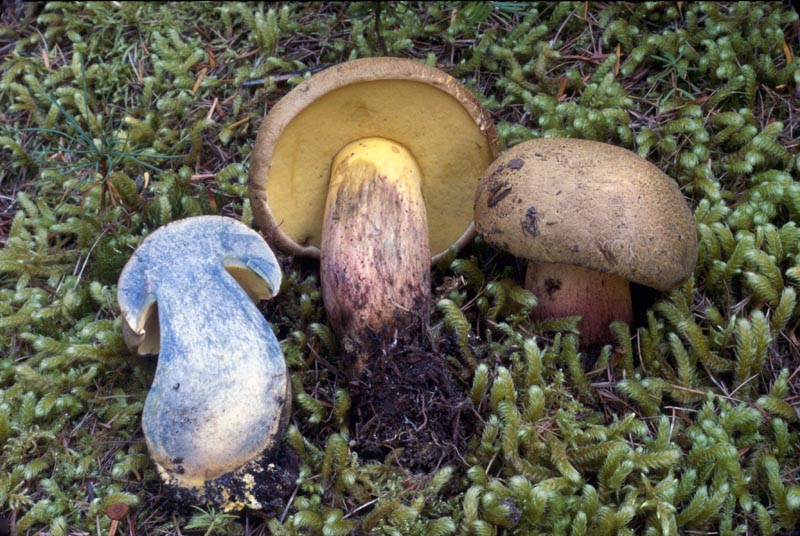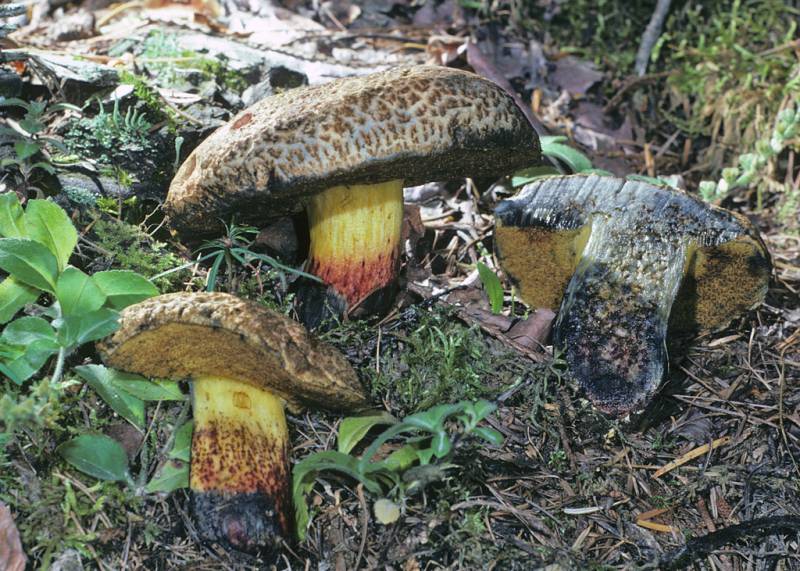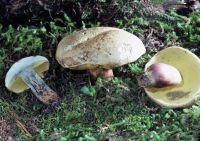Distribution: Widespread but not particularly common in the PNW region.
Habitat: It was described from coastal conifer and mixed forests in California, but in the PNW, occurs in montane conifer forests.
Spores: summer and fall
Conservation Status: Not of concern
Edibility: BItter-tasting. Inedible.
bitter bolete, red-stemmed bitter bolete
Cap: 6-15 cm broad, convex to broadly convex or sometimes plane; surface dry, dull, smooth or velvety, often becoming cracked or furrowed in age; pale buff to olive-buff to tan. Flesh thick, firm, buff to pale yellow or even whitish, but blueing when exposed; taste usually bitter. Pores: pale yellow becoming darker or duller yellow in age; blueish when bruised. Stalk: 7-13 cm long, 1-4 cm thick, sometimes swollen below (especially when young), but often more or less equal in age; firm, solid, not reticulate but often longitudinally striate in age; color variable, but usually yellow at apex with bright pink to reddish areas below, becoming dark red throughout in age.
BItter-tasting. Inedible.
Boletus rubripes is medium-sized to larger, with a dry, matted tomentose to fibrillose, pale buff to olive brown or more brownish cap; the surface sometimes cracks in dry weather, but does not develop reddish colors like B. chrysenteron. B. rubripes has yellow tubes and pores that readily stain blue when bruised or cut, a feature it shares with a number of similar species including B. coniferarum and B. smithii. The name “rubripes” (red foot in Latin) refers to the lower portion of the stipe which is some shade of red. The stipe apex is yellow and it is not reticulate like that of B. coniferarum, although the lower portion may become ridged or striate. The base usually is covered by yellow mycelium. The flesh is bitter, cream to yellow or rarely pinkish in the cap, white to yellow in the upper stipe, and red to vinaceous in the base; when cut, it instantly changes to blue. It was described from coastal conifer and mixed forests in California, but in the PNW, occurs in montane conifer forests where one is likely to also encounter B. calopus. The latter is similar in coloration and bitterness, but has a reticulate stipe apex.
Sources: Trudell, Steve and Joe Ammirati. Mushrooms of the Pacific Northwest. Portland, Timber Press, Inc. 2009. Arora, David. Mushrooms Demystified. Berkeley, Ten Speed Press, 1986.
PNW Herbaria: Specimen records of Boletus rubripes in the Consortium of Pacific Northwest Herbaria database.
CalPhotos: Boletus rubripes photos.







